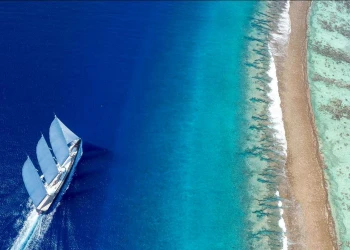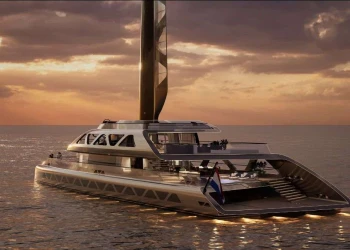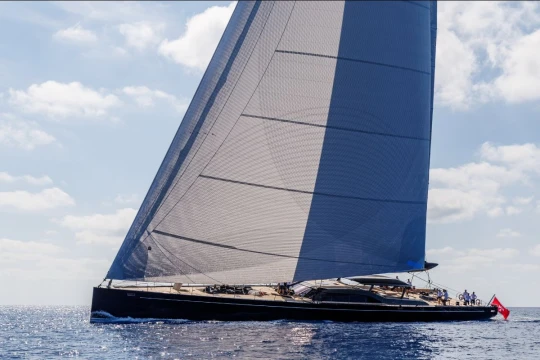
Royal Huisman: destined for global stardom
Royal Huisman: destined for global stardom
Royal Huisman's Nilaya, a Reichel / Pugh - Nauta Panamax sloop, sailed into English Harbour, Antigua, after a fast Atlantic crossing that gave her owner and pro race team captain Bouwe Bekking and skipper Romke Loopik plenty of all-conditions experience at the helm. Delivered to her owners in June, 47m / 154ft Nilaya spent the summer cruising in the Med and tuning up for racing.
With this pause before the St. Barth's Bucket and with over 10,000nm under her keel, Royal Huisman can shine a spotlight on the yacht that pioneered the shipyard's comprehensive Featherlight™ approach. Delivering on the owners' brief for speed, safety, reliability and silence, Royal Huisman and Nauta Design explored every option to produce a bluewater cruiser packed with luxury amenities that blends the strength and motion of an aluminum hull with the speed and displacement weights common to carbon fiber maxi yachts.
"My previous yacht was [an all-carbon Reichel/Pugh-Nauta] Baltic 34m / 112ft. She was a fantastic yacht which we cruised all over the world and won many regattas," shared Nilaya's owner. During the 12 years I owned her, it became clear what my next yacht would be. The brief that I gave to Nauta and Reichel / Pugh was for more comfort in a fast yacht that can win a superyacht regatta," he said.
However, to win the contract to build this boat, Royal Huisman had to demonstrate it could build an aluminum yacht much lighter than current alloy construction techniques would indicate. It would require much more than turning to carbon fiber for deck hatches and a coach roof. To do this, Royal Huisman created an engineering approach based on European Space Agency methodology. The result is that Nilaya is a true aluminum / carbon hybrid. Extensive use of finite element analysis (FEA) directed the right material and thickness for the exact stresses and loads of every part of the hull and deck. More than a simple case of choosing either / or, in some places carbon backs Alustar aluminum, increasing stiffness without adding weight and bulk.
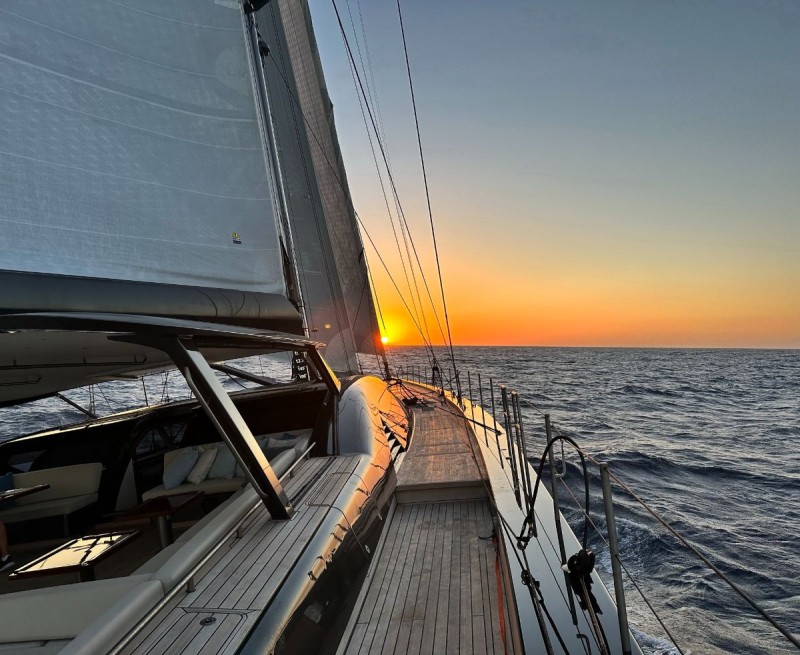
When Nauta Design and Reichel/Pugh approved the concept, Royal Huisman won the bid to produce arguably the most advanced sailing yacht it has yet delivered. Continuous weight monitoring throughout the build achieved the ambitious goal of slicing 11% of the construction weight of its typical advanced aluminum cruising yachts with equipment, sailing and mechanical systems and interior furnishings creating more savings for a 15% total reduction. Most importantly, it has achieved weight reduction without sacrificing stiffness or cutting corners on quality, and without the noise typical of carbon fiber hulls.
She cuts no corners on livability, either. Project 405, as she was originally tagged, marks the second time US naval architects Reichel/Pugh and Italian design studio Nauta combined on a project for these owners. The new Nilaya features 2.5m / 8ft more beam and 13m / 42.5ft more length over the predecessor, the increase in interior volume as well as on-deck living area is immense. Jim Pugh adds: "The new Nilaya is not in any way a development of her predecessor, naval architecture has come a long way since the design of the first Nilaya. Our knowledge base has expanded dramatically and the CFD hydro tools we now use provide far more accurate computational results, both in flat water and waves. The new Nilaya's naval architecture is the beginning of a new era in Superyacht design."
With their new Nilaya, the owners wanted to maintain the lightweight benefits of carbon but within a quiet yacht that felt solid and built to the highest standards for world cruising. The build was a delicate balance of choosing the best materials and using them in all the right places.
To meet racing and cruising requirements, Nauta Design developed three distinct outdoor areas. The almost 10m / 31ft wide transom includes a hinged section of the aft deck that folds out to rest on top of the beach platform forming a staircase that lifts for launching the crew tender. The aft section also has two sun loungers with L-shaped backrests and an aft-facing sofa and folding coffee table. The raised aft bulwarks can be used for seating and two steps lead to the crew companionway and double helm positions. Well separated from the helm and the forward social cockpit, this area can be easily tented by means of an awning and carbon fiber poles. A delightful lounging and dining area forward of the mast, created when the tender is offloaded, can also be tented.
The guest cockpit for outdoor dining or relaxation is shaded by a carbon composite hardtop with windows that can be closed for protection. Originally, this area was going to be partially enclosed by a bimini hardtop removable for racing.
To validate this concept the entire deck area from mast to stern was mocked up 1:1 – her bow simulated in the distance – and the owners felt comfortable choosing a semi-permanent structure. This alfresco area and the main salon at almost the same level fulfill the owners' brief for 360-degree views.
To meet exacting performance demands, Reichel/Pugh undertook an extensive CFD seakeeping study. The goal was to improve the seakeeping and motion while motoring upright and sailing at various speeds and angles of heel in different wave conditions. R/P used 10 years of historical wave data from the Eastern Caribbean and Greece, ultimately testing 12 models before development of the final hull shape.
"Weight distribution is critical for assuring comfortable motion on a cruising yacht," John Reichel said. "We gave the build team a weight study early on, not just for the total but for balance and maintaining the proper center of gravity. Royal Huisman responded with extensive weight reports and spreadsheets showing the weight of every element and assigned a dedicated weight engineer. That's a process typical of the construction of a high-end racing yacht."
Rondal created a radical new curved carbon fiber spreader design that is shorter and more aerodynamic than anything previously available
to allow narrower headsail sheeting angles. Most deck hardware is titanium.
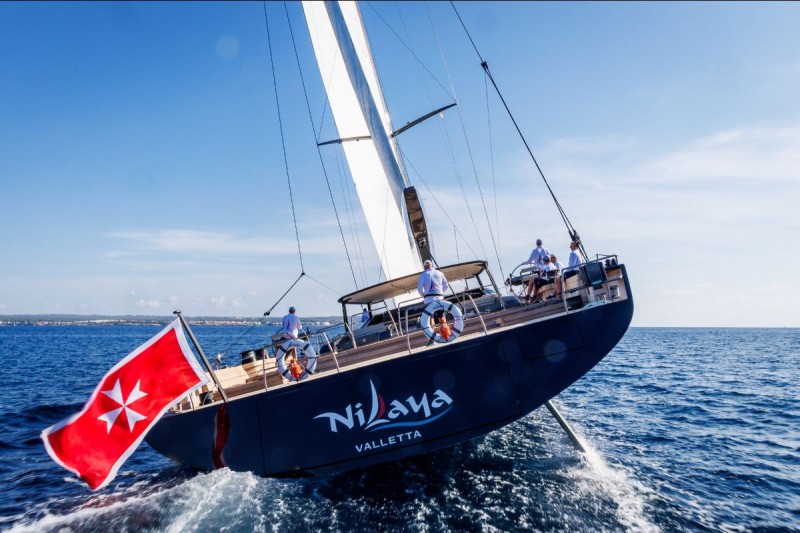
Royal Huisman would be building with an alloy called Alustar, a product that already has 20% more strength than typical aluminum. "Royal Huisman used Finite Element Analysis (FEA) of Nilaya's 3D model to engineer the structure to a very high level," and according to Jim Pugh, "accurately predicted longitudinal stiffness, strength and VCG." FEA modelling enabled selecting various construction materials and adjust Alustar plate thicknesses and frame spacing to maximize hull stiffness while minimizing total displacement.
Nilaya's build was a three-year process – a year of preparation and two years in construction, the early part taking place during the Covid pandemic. With engineering and weight management brought in-house, and carbon fiber expertise augmented by Royal Huisman's sister company, Rondal, the approach was comprehensive, extending to sails from Doyle, sailing gear, lighting, insulation, furnishings, and all mechanical systems. Realizing that the yard was developing a unique approach, it coined the term Featherlight™ for the process and documented every step into a repeatable approach and process.
Rondal supplied the mast and boom, but also deck hardware and product innovations such as a runner arrangement that saves 1,200kg / 2,646lbs. Rondal's new generation hybrid captive winch with aluminum frame and carbon drums saved half the weight of previously available winches. Tapering the top of the mast on all four sides and eliminating a headboard lock in favor of a unique hook to capture and hold the mainsail are innovations that saved 150kg / 331lbs in a position that made an important positive impact on the yacht's center of gravity. Beyond sailing performance, another positive result of Featherlight™ means the yacht needs less power for motoring, a factor that leaves more space to the interior accommodation. Less power required translates to smaller engines, and in this case, one less generator and gearbox, thus saving 2,000kg / 4,409lbs. The propeller can be powered in two ways: mechanical (directly from the engine) and/or electrical (either from batteries or a generator).
The interior, too, benefited from careful weight analysis. Drawing on its expertise designing performance yachts, Nauta designed all interior structural members to utilize lightweight materials. Some bulkheads and door frames are carbon. Traditionally, reducing noise and vibration requires the addition of weighty insulation materials. To stay within the interior weight budget, Royal Huisman made extensive sound attenuation studies and developed sophisticated composite panels utilizing cork, foam, honeycomb and other materials. This innovative approach narrows the displacement gap between aluminum and carbon composite yachts. Nilaya is the largest sailing yacht yet in Nauta Design's portfolio. Her interior consists of the forward full beam owners' suite, the VIP cabin and the TV lounge forward of the main saloon, two guest cabins, galley, crew mess, chart table, engineer's station, and four double crew cabins aft of the main salon.
"The owners wanted a powerful performer with easy-to-helm responsiveness; basically, all the good habits of the last boat, but with more comfort and the lower sound levels that can be experienced on aluminum yachts. Royal Huisman was not afraid to invest in research to explore and develop all manner of innovative weight-saving possibilities. They really chased the details," said the owners' newbuild project manager Nigel Ingram of MCM Newport. Nilaya, after all, means "blissful home" in Sanskrit. The interior looks cozy yet is practical for racing with minimal time needed to secure the guest areas.
Mario Pedol, co-founder of Nauta Design, noted following his overall experience during sail trials on the North Sea: "Nilaya is not good... She is superb."
Jim Pugh adds: "Sailing Nilaya in Palma was impressive, seriously amazing performance for a superyacht. While we sailed in only in sub 10 [knots] TWS, it was remarkable how responsive Nilaya was. This yacht is going to turn some heads wherever she is, but particularly at the Bucket."
"We just finished an Atlantic crossing and I must admit that the yacht is very comfortable and fast; congratulations to Reichel / Pugh, Nauta and Royal Huisman," said Nilaya's owner.
"While many aluminum superyachts have some composite parts, Royal Huisman Project 405 is much more a hybrid, possibly the first true performance superyacht with luxury comfort levels," says CEO Jan Timmerman. "Comfortable, robust characteristics of an aluminum yacht are now a viable option for owners seeking genuine sailing performance for enjoying time at sea either on or below deck."
Timmerman also said, "I am proud of the investment we have made in sophisticated 'out-of-the-box' approach for engineering and of the way teams from Royal Huisman and Rondal stepped up to advance new solutions in order to meet the brief from very knowledgeable and experienced yachtsmen and their visionary designers."





